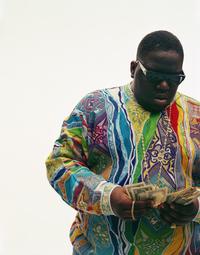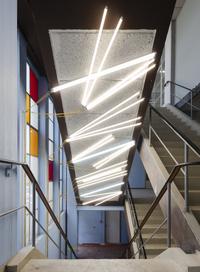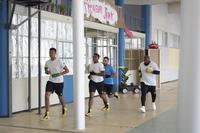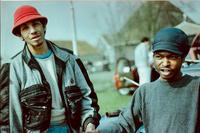‘One last question about your painting,’ the radiomaker Bram van Splunteren asks RAMM:ΣLL:ZΣΣ during an interview for the VPRO in 1986.
‘Throw it out the window,’ RAMM:ΣLL:ZΣΣ replies.
‘You don’t take what you’re doing seriously?’ asks Bram.
‘Hell no.’ RAMM:ΣLL:ZΣΣ laughs, and then goes on to explain that there is a big difference between his music (experimental rap) and his painting, which he calls Iconoclast Panzerism.
In the early 80s, the now legendary Amsterdam gallery owner Yaki Kornblit brought a number of graffiti artists to Amsterdam to exhibit in his gallery. RAMM:ΣLL:ZΣΣ was one of the artists invited by Kornblit, alongside other graffiti celebrities such as Dondi, Futura and Blade.
Graffiti was a relatively new phenomenon in Amsterdam at that time, certainly in the vibrant form as it was practiced in New York. The work of RAMM:ΣLL:ZΣΣ distinguished itself within the genre. Where graffiti was characterised by the stylish spraying of one’s own name within agreed style rules, RAMM:ΣLL:ZΣΣ had already prepared a manifesto in 1979 about his way of thinking about letters and graffiti. In addition, rather than producing pieces in the New York City Subway, he often worked in his studio, sometimes together with artist friends such as Jean-Michel Basquiat and A-One.
In 1983, RAMM:ΣLL:ZΣΣ had his first exhibition outside New York: Amsterdam. Yaki had already sold one of RAMM:ΣLL:ZΣΣ’s drawings before the exhibition had even opened. Yaki also arranged a workspace in an old factory in the Jordaan’s Gietersstraat. This was a place where RAMM:ΣLL:ZΣΣ could expand. He started experimenting with materials, such as epoxy, producing works in which all kinds of objects were cast.
His first exhibition was sold out immediately. This was a significant moment of recognition for RAMM:ΣLL:ZΣΣ, both for his practice and the idiosyncratic thought process it was founded on. He exhibited at Kornblit every year, right up until 1993. Large museums and collectors purchased his work. RAMM:ΣLL:ZΣΣ also exhibited outside the Netherlands. In 1987 he had a solo exhibition at the Groninger Museum.
He opened every exhibition with a rap performance. Kornblit: ‘I’ve presented RAMM:ΣLL:ZΣΣ’s work more than any other artist. At every opening he would give these fantastic performances. His costumes just got bigger and bigger, better and better.’
RAMM:ΣLL:ZΣΣ was incredibly active in Amsterdam. He was always working. ‘A born artist,’ remarks Kornblit. Outside Amsterdam, RAMM:ΣLL:ZΣΣ enjoyed a great working relationship with collector Vincent Vlasblom. With fellow artist A-One, RAMM:ΣLL:ZΣΣ converted his 12-cylinder Daimler into a tank, and used it to drive to Documenta. (The beast was removed from the motorway before they even reached the border.)
Both Vlasblom and Kornblit still speak highly of RAMM:ΣLL:ZΣΣ. They were the ones who gave him the confidence to develop himself and, working from Amsterdam, gave him the international recognition he deserves as a truly exceptional artist.
Despite RAMM:ΣLL:ZΣΣ’s somewhat laconic remarks about his own work during a radio interview with VPRO in 1986, it is clear that he can now be regarded as one of the most influential artists of early hip-hop culture and contemporary modern art.









